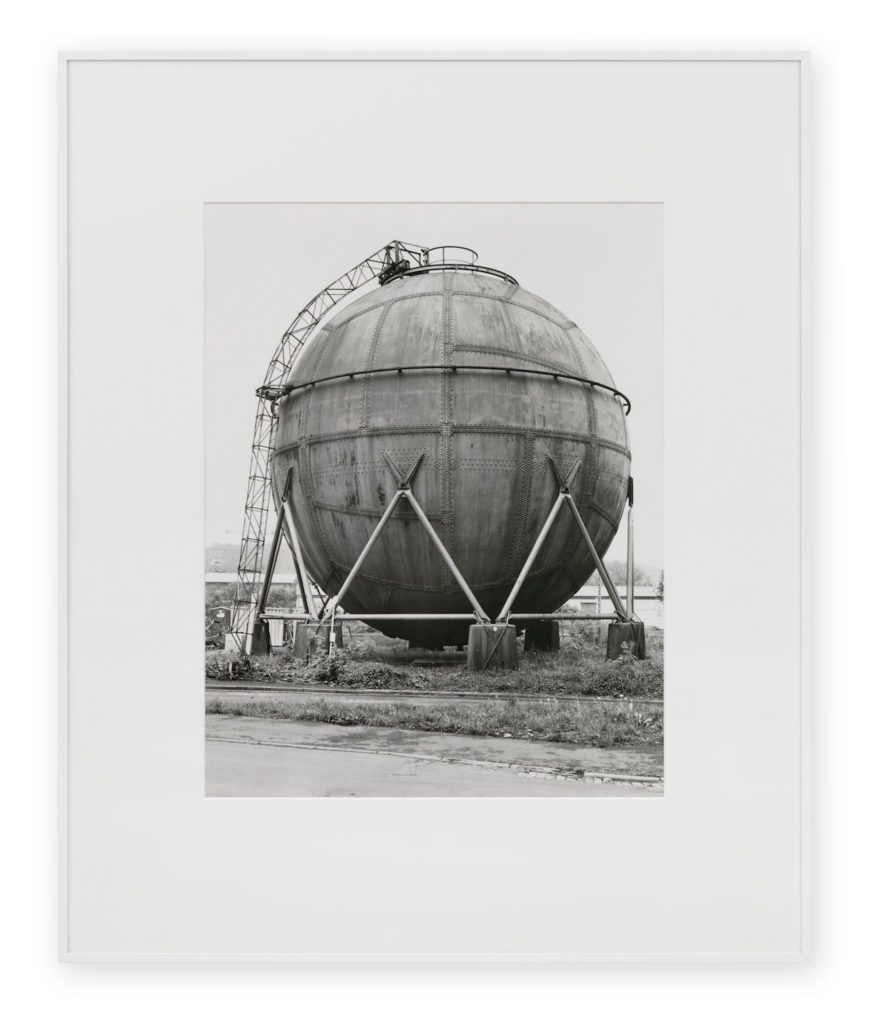BJP. “He only used photography once in a while, because his subjects were disappearing and he wasn’t fast enough to record them. He started making photo-montages, but they were quite messy, I must say. I was a little more conceptual I think.
“Finally he gave up drawing these things,” she says. “He was too much of a perfectionist.” A pause, and then: “I still have lots of his drawings; I still look at them occasionally.”
[caption id="attachment_20423" align="aligncenter" width="779"] Ilsede/Hannover, D, 1984 © Estate Bernd and Hilla Becher, courtesy the Estate and Hauser & Wirth[/caption]
I ask Hilla what sparked between them, what served as a shared purpose, in those early, formative years. She gives a little shrug. “We talked a lot,” she says. Yet their meeting, on what’s thought of as the wrong side of the Berlin Wall, sparked a partnership that would help define the course of photography in the twentieth century.
One of Bernd’s earliest photographs was the Eisenhardter Tiefbau mine near his family home in Siegen, Germany. He grew up with a blast furnace as a playground. “So it is hardly surprising,” he once said, “that I was overcome with horror when I noticed that the world in which I was besotted was disappearing.”
His relationship with Hilla allowed him to immortalise this landscape. Together, they dedicated themselves to an architectural photography project that would span more than forty years, their photographs providing “a portrait of a lost world,” according curator Emma Daxter. For the Bechers photographed, with the exacting and exhaustive discipline of a botanist, the distinct era of industry.
They worked first their native Germany, then through France, Italy and then the UK. In 1966, they travelled through England and South Wales for six months, taking hundreds of photographs of the coal industry around Liverpool, Manchester, Sheffield, Nottingham and the coal mining communities of Rhondda Valley.
With their cool, objective eye, their gelatin silver prints and large-format plate cameras, they sought out what have become elephant’s graveyards of architecture. Coal bunkers, cement works, complexes of factory buildings, grain elevators, water coolants and blast furnaces.
These giant, hard-edged structures, at odds in the untamed landscapes of central Europe, are aesthetic blights in other’s hands, eyesores on the beauty of the natural world. The Bechers turned them into proud and defiant examples of human creation; places of hard work and productivity in a world still picking itself up from total war.
[caption id="attachment_20422" align="aligncenter" width="785"]
Ilsede/Hannover, D, 1984 © Estate Bernd and Hilla Becher, courtesy the Estate and Hauser & Wirth[/caption]
I ask Hilla what sparked between them, what served as a shared purpose, in those early, formative years. She gives a little shrug. “We talked a lot,” she says. Yet their meeting, on what’s thought of as the wrong side of the Berlin Wall, sparked a partnership that would help define the course of photography in the twentieth century.
One of Bernd’s earliest photographs was the Eisenhardter Tiefbau mine near his family home in Siegen, Germany. He grew up with a blast furnace as a playground. “So it is hardly surprising,” he once said, “that I was overcome with horror when I noticed that the world in which I was besotted was disappearing.”
His relationship with Hilla allowed him to immortalise this landscape. Together, they dedicated themselves to an architectural photography project that would span more than forty years, their photographs providing “a portrait of a lost world,” according curator Emma Daxter. For the Bechers photographed, with the exacting and exhaustive discipline of a botanist, the distinct era of industry.
They worked first their native Germany, then through France, Italy and then the UK. In 1966, they travelled through England and South Wales for six months, taking hundreds of photographs of the coal industry around Liverpool, Manchester, Sheffield, Nottingham and the coal mining communities of Rhondda Valley.
With their cool, objective eye, their gelatin silver prints and large-format plate cameras, they sought out what have become elephant’s graveyards of architecture. Coal bunkers, cement works, complexes of factory buildings, grain elevators, water coolants and blast furnaces.
These giant, hard-edged structures, at odds in the untamed landscapes of central Europe, are aesthetic blights in other’s hands, eyesores on the beauty of the natural world. The Bechers turned them into proud and defiant examples of human creation; places of hard work and productivity in a world still picking itself up from total war.
[caption id="attachment_20422" align="aligncenter" width="785"] Terre Rouge, Esch-Alzette, L, 1979 © Estate Bernd and Hilla Becher, courtesy the Estate and Hauser & Wirth[/caption]
This journey was taken independently, and almost entirely without recognition. “But you don’t care,” Hilla says. “You’re not surprised that people aren’t interested in your own work. The more you get into a subject, the more interesting it becomes. Finally you’re pushed by historical ongoings.
“In our case, lots of things changed. The area where Bernd was from; it was changing. We became curious. I wanted to go on and on to a bigger area, so I pushed him. I said: ‘We have to go out, to other countries’.”
This categorical, rigorous, almost scientific approach to photography, allied with this boundless curiosity about the broader world was grounded in their upbringing. “There was no hope for success back then,” Hilla Becher says of a childhood learning about art behind the Iron Curtain. “We did it for ourselves. Any discipline we had came from ourselves; if any of us had any success, it came late. In our case, it was really late.”
This absence of contemporary stimuli, and the forced focus on technique, provided the basis of their success. “The people who came from the East had an education,” she says of her side of Germany. “Young people from East Germany were much better off, because they had no chances to develop freely. The Western artists said: ‘I don’t need this. I’m already a genius.’ So finally, the people from the East were more successful.”
In 1976, as the world of photography started to recognise the Becher’s work with the rise of the New Topographic movement, Becher started putting this theory into practice. He taught photography at the Kunstakademie Düsseldorf. But she, as a matter of policy, was excluded.
I ask Hilla about the guiding principle of their time teaching together. She corrects me: “We didn’t teach together; he was the master, and that was the time.” What was his principle then, I ask. “His principle was he didn’t show up very often,” she says without skipping a beat.
[caption id="attachment_20420" align="aligncenter" width="784"]
Terre Rouge, Esch-Alzette, L, 1979 © Estate Bernd and Hilla Becher, courtesy the Estate and Hauser & Wirth[/caption]
This journey was taken independently, and almost entirely without recognition. “But you don’t care,” Hilla says. “You’re not surprised that people aren’t interested in your own work. The more you get into a subject, the more interesting it becomes. Finally you’re pushed by historical ongoings.
“In our case, lots of things changed. The area where Bernd was from; it was changing. We became curious. I wanted to go on and on to a bigger area, so I pushed him. I said: ‘We have to go out, to other countries’.”
This categorical, rigorous, almost scientific approach to photography, allied with this boundless curiosity about the broader world was grounded in their upbringing. “There was no hope for success back then,” Hilla Becher says of a childhood learning about art behind the Iron Curtain. “We did it for ourselves. Any discipline we had came from ourselves; if any of us had any success, it came late. In our case, it was really late.”
This absence of contemporary stimuli, and the forced focus on technique, provided the basis of their success. “The people who came from the East had an education,” she says of her side of Germany. “Young people from East Germany were much better off, because they had no chances to develop freely. The Western artists said: ‘I don’t need this. I’m already a genius.’ So finally, the people from the East were more successful.”
In 1976, as the world of photography started to recognise the Becher’s work with the rise of the New Topographic movement, Becher started putting this theory into practice. He taught photography at the Kunstakademie Düsseldorf. But she, as a matter of policy, was excluded.
I ask Hilla about the guiding principle of their time teaching together. She corrects me: “We didn’t teach together; he was the master, and that was the time.” What was his principle then, I ask. “His principle was he didn’t show up very often,” she says without skipping a beat.
[caption id="attachment_20420" align="aligncenter" width="784"] Zeche Hannibal, Bochum, Ruhrgebiet, D, 1973 © Estate Bernd and Hilla Becher, courtesy the Estate and Hauser & Wirth[/caption]
Despite this, Becher’s involvement with the historic school meant photography gradually became a core part of a curriculum traditionally focused on sculpture and painting. Photography was seen as a bastardised, lesser art by some of his colleagues, and Bernd had to fight his corner. It did not, however, mean he indulged his students.
“Bernd was a little limited in teaching his students to experiment,” Hilla says today. “Because he always wanted them to be perfect.” Whether he was there or not, he must have been doing something right; in his time at the Kunstakademie he taught students like Andreas Gursky, Thomas Ruff, Thomas Struth, Candida Höfer and Elger Esser. And, in this historic artist’s city of more than a hundred art galleries, they’re now treated as royalty.
What would she say to the girl now, of 23, who was meeting Bernd for the first time, I finally ask. “Be careful,” she says with a lovely, youthful smile. “He wasn’t that easy. Bernd was a little crazy.”
Bernd and Hilla Becher is on show at Hauser & Wirth Zürich from 14 October-22 December www.hauserwirth.com www.duesseldorfphotoweekend.de
[caption id="attachment_20263" align="aligncenter" width="840"]
Zeche Hannibal, Bochum, Ruhrgebiet, D, 1973 © Estate Bernd and Hilla Becher, courtesy the Estate and Hauser & Wirth[/caption]
Despite this, Becher’s involvement with the historic school meant photography gradually became a core part of a curriculum traditionally focused on sculpture and painting. Photography was seen as a bastardised, lesser art by some of his colleagues, and Bernd had to fight his corner. It did not, however, mean he indulged his students.
“Bernd was a little limited in teaching his students to experiment,” Hilla says today. “Because he always wanted them to be perfect.” Whether he was there or not, he must have been doing something right; in his time at the Kunstakademie he taught students like Andreas Gursky, Thomas Ruff, Thomas Struth, Candida Höfer and Elger Esser. And, in this historic artist’s city of more than a hundred art galleries, they’re now treated as royalty.
What would she say to the girl now, of 23, who was meeting Bernd for the first time, I finally ask. “Be careful,” she says with a lovely, youthful smile. “He wasn’t that easy. Bernd was a little crazy.”
Bernd and Hilla Becher is on show at Hauser & Wirth Zürich from 14 October-22 December www.hauserwirth.com www.duesseldorfphotoweekend.de
[caption id="attachment_20263" align="aligncenter" width="840"] Bonn, D 1992 © Estate Bernd and Hilla Becher, courtesy the Estate and Hauser & Wirth[/caption]
[caption id="attachment_20262" align="aligncenter" width="840"]
Bonn, D 1992 © Estate Bernd and Hilla Becher, courtesy the Estate and Hauser & Wirth[/caption]
[caption id="attachment_20262" align="aligncenter" width="840"] Wetter a.d. Ruhr, D 1969 © Estate Bernd and Hilla Becher, courtesy the Estate and Hauser & Wirth[/caption]
[caption id="attachment_20261" align="aligncenter" width="840"]
Wetter a.d. Ruhr, D 1969 © Estate Bernd and Hilla Becher, courtesy the Estate and Hauser & Wirth[/caption]
[caption id="attachment_20261" align="aligncenter" width="840"] Siegen, D 1993 © Estate Bernd and Hilla Becher, courtesy the Estate and Hauser & Wirth[/caption]
]]>
Siegen, D 1993 © Estate Bernd and Hilla Becher, courtesy the Estate and Hauser & Wirth[/caption]
]]>
Reading Time: 5 minutes
No Comments Yet
